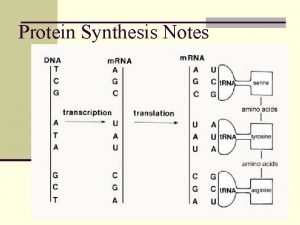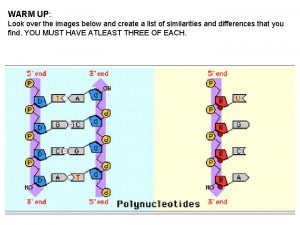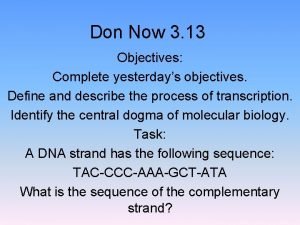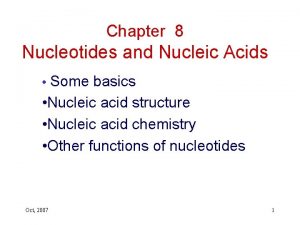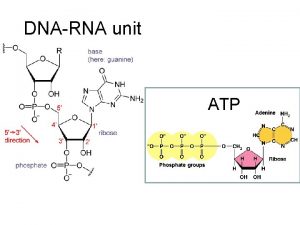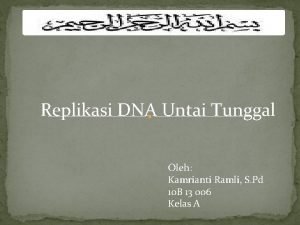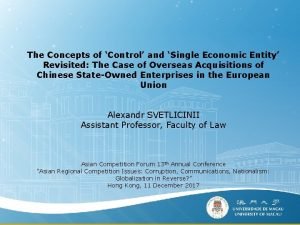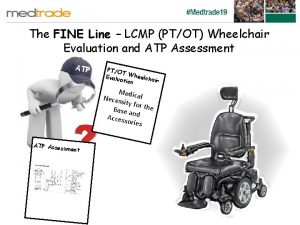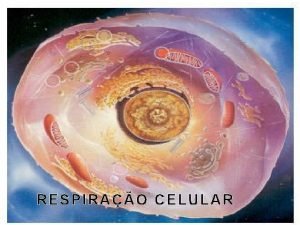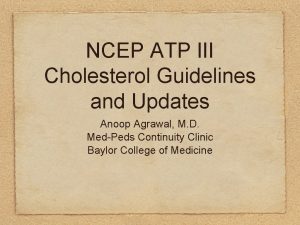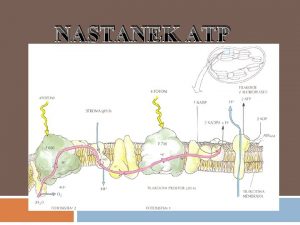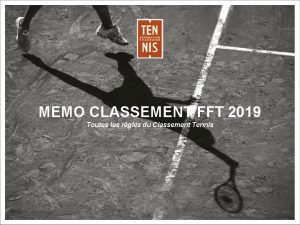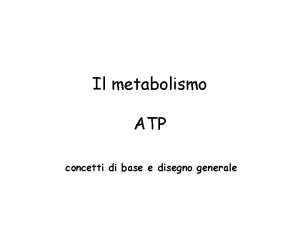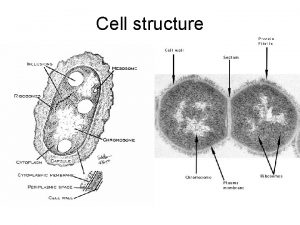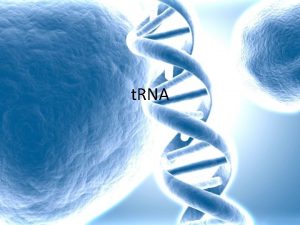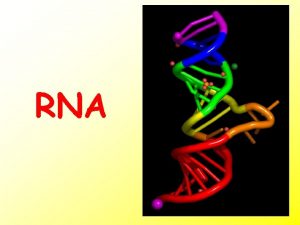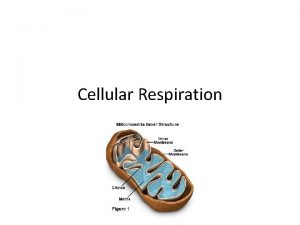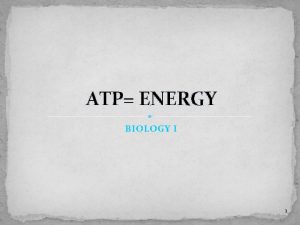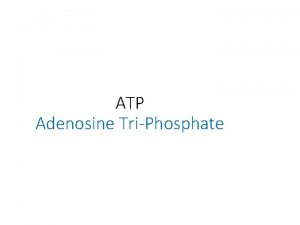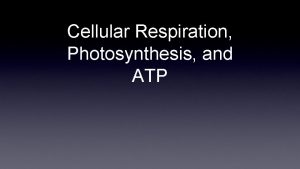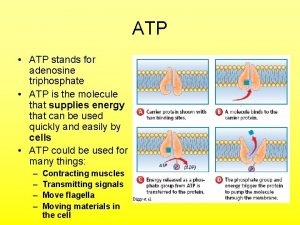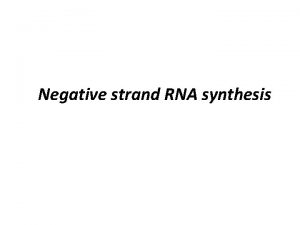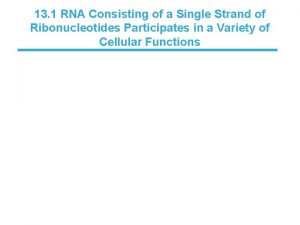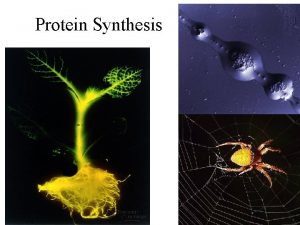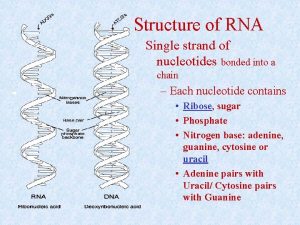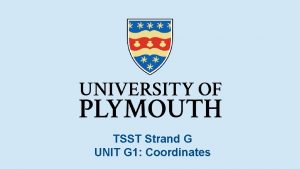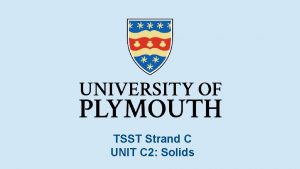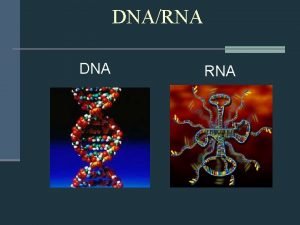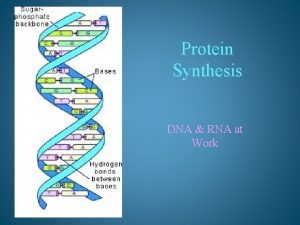DNARNA unit ATP RNA Nucleoid Single strand of





























- Slides: 29

DNA-RNA unit ATP


RNA

Nucleoid • Single strand of DNA, usually circular, usually looks like a big ball of messed up twine… • Size – smallest organism yet discovered (Nanoarchaeum equitans) 490, 889 base pairs; e. coli 4. 7 Mbp, most prokaryotes 1 -6 million base pairs (1 -6 MBp); Humans 3300 MBp • DNA is around 1000 mm long in bacteria, while the organism is on the order of 1 mm long – special enzymes called gyrases help coil it into a compact form

Ribosomes • Ribosomal RNA is single stranded • RNA is a single stranded nucleic acid – m. RNA- messanger RNA – copies information from DNA and carries it to the ribosomes – t. RNA – transfers specific amino acids to the ribosomes – r. RNA – ribosomal RNA – with proteins, assembles ribosomal subunits DNA is transcribed to produce m. RNA then translated into proteins.

RNA and protein construction • The nucleotide base sequence of m. RNA is encoded from DNA and transmits sequences of bases used to determine the amino acid sequence of the protein. • m. RNA (“Messenger RNA”) associates with the ribosome (m. RNA and protein portion). • RNA (“Transfer RNA”) also required • Codons are 3 base m. RNA segments that specify a certain amino acid. • Most amino acids are coded for by more than one codon: degenerage genetic code. • Translation ends when ribosome reached “stop codon” on m. RNA.

Transcription RNA polymeraze takes the DNA and temporarily unwinds it, templates the transfer RNA from that, using ribonucleoside triphosphates to assemble…

Translation • m. RNA is coded for one or more specific amino acids and moves to the ribosome to assemble amino acids into proteins • On m. RNA, codons are 3 bases, coded to specific amino acids • On t. RNA, the anticodon latches to the codon on the m. RNA

Protein Formation • The ‘code’ on m. RNA determines the sequence of protein assembly

r. RNA • Ribosomes are made of proteins and r. RNA, the t. RNA and m. RNA come to it and assemble the proteins • r. RNA plays a structural role, serving as a support for protein construction, and a functional role • r. RNA consists of two subunits, one 30 S in size (16 S r. RNA and 21 different proteins), one 50 S in size (5 S and 23 S r. RNA and 34 different proteins). The smaller subunit has a binding site for the m. RNA. The larger subunit has two binding sites for t. RNA.


Microbial Genomics • Study of the gene sequence of an organism

• Tree of Like – Ernst Haekel, 1866

Tree of Life

• Global phylogeny of fully sequenced organisms. The phylogenetic tree has its basis in a cleaned and concatenated alignment of 31 universal protein families and covers 191 species whose genomes have been fully sequenced (14). Green section, Archaea; red, Eukaryota; blue, Bacteria. Labels and color shadings indicate various frequently used subdivisions. The branch separating Eukaryota and Archaea from Bacteria in this unrooted tree has been shortened for display purposes. http: //www. sciencemag. org/cgi/content/full/311/5765/1283/FIG 2

Construction of phylogenies • What piece of the genetic code is most appropriate for determining these relationships – what should that part of DNA be responsible for? ? ? – – Homologous function (common to all organisms) Larger is better (more info) Rate of mutation accumulation relevant to evolution Does it all make sense – i. e. , when you look at the phylogeny does it make sense? – function and evolution? ?

Comparative sequence analysis • Looking to compare similarity (in base 4) of sequences 1. 2. 3. 4. • ATTGGCCACG ATTCGCCTCG TGGCGCCTTT ATTGGGCACG Determine the ‘degree of similitude’ between these and represent that graphically 1 3 4 2 • Literally hundreds of ways to do this…

What piece of DNA do we use • 16 S r. RNA coding – info that is responsible for the 16 S subunit in ribosomes – All bacteria and archea have 70 S ribosomes with a 16 S subunit – All bacteria and archaea need this to make proteins – Some parts accumulate mutation slow, other parts fast (evolution resolved over long time but also with good resolution) After original work of Carl Woese and colleagues

OK – How do we get genetic data? • DNA extraction • Since DNA is more stable, easier to extract and preserve than is r. RNA • Need to get the DNA ‘out’ of the organism – Bead beating – Chemical – Thermal • Purify this material through chemical and physical extraction/filtration • A multitude of techniques exist to do this – often specific for the type of sample • Why? ?

Now that you have the DNA… • For most techniques, even for the high cell densities of biofilms or cultures, there is nowhere near enough material to actually analyze • While the genetic code was known about for many years, it was a special discovery by a surferscientist, Kary Mullis, that kick-started modern molecular biology – PCR (for which he received the 1993 Nobel Prize in Chemistry) • Based on thermal tolerance of a DNA polymerase first isolated from thermophile Thermus aquaticas (thus Taq polymerase)

• The first part of Mullis's idea was to use pairs of short, single-stranded DNA pieces as probes to bracket the exact DNA sequence in which you happened to be interested. You could then cleverly employ iterative biochemical processes to get that DNA sequence to 'reproduce the hell out of itself'. You could start with the tiniest samples of even impure DNA and wind up within hours with a test-tube full of whatever gene or DNA sequence you had targeted. 'I would be famous, ' Mullis recalls thinking at the moment of discovery, 'I would get the Nobel Prize. ' • The discovery of PCR is here presented as a great American epiphany - its recipient struck by a flash of inspiration on the road, not to Damascus, but to Mendocino. Sometimes Mullis says the creative spirit came on an evening in April of 1983, sometimes in May. Anyway, the buckeyes were in bloom; Mullis's little silver Honda Civic was purring through the vineyards and redwoods of the Anderson Valley; and his mind wandered. Life is sweet, he thought: 'I am a big kid with a new car and a full tank of gas. I have shoes that fit. I have a woman sleeping next to me and an exciting problem, a big one. ' At mile-marker 46. 58 on Highway 128 - he had both the presence of mind and the sense of history to note the exact spot, if not the month - the epiphany arrives. 'Holy shit, ' Mullis cries out, and his girlfriend almost, but not quite, wakes up. He pulls the Honda to the side of the road to write down his ideas and check his calculations. Within feverish minutes, the problem is solved, and Mullis is left with the mop-up operation of getting PCR actually to work. This takes almost two years, and the original report was famously rejected by both Nature and Science. Mullis was not fazed: '"Fuck them, " I said. ' Excerpts from ‘Dancing Naked in the Mind Field’ by Kary Mullis

PCR - Polymerase Chain Reaction • PCR is an in vitro technique for the amplification of a region of DNA which lies between two regions of known sequence. • PCR amplification is achieved by using oligonucleotide primers. – These are typically short, single stranded oligonucleotides which are complementary to the outer regions of known sequence. • The oligonucleotides serve as primers for DNA polymerase and the denatured strands of the large DNA fragment serves as the template. – This results in the synthesis of new DNA strands which are complementary to the parent template strands. – These new strands have defined 5' ends (the 5' ends of the oligonucleotide primers), whereas the 3' ends are potentially ambiguous in length.



Primer selection • Primer is an oligonucleotide sequence – will target a specific sequence of opposite base pairing (A-T, G-C only) of single-stranded nucleic acids • For example, there is a – ¼ chance (4 -1) of finding an A, G, C or T in any given DNA sequence; there is a – 1/16 chance (4 -2) of finding any dinucleotide sequence (eg. AG); a – 1/256 chance of finding a given 4 -base sequence. • Thus, a sixteen base sequence will statistically be present only once in every 416 bases (=4 294 967 296, or 4 billion): this is about the size of the human or maize genome, and 1000 x greater than the genome size of E. coli.

Primer Specificity • Universal – amplifies ALL bacterial DNA for instance • Group Specific – amplify all denitrifiers for instance • Specific – amplify just a given sequence

Forward and reverse primers • If you know the sequence targeted for amplification, you know the size which the primers should be anealing across • If you don’t know the sequence… What do you get?

DNA Polymerase • DNA Polymerase is the enzyme responsible for copying the sequence starting at the primer from the single DNA strand • Commonly use Taq, an enzyme from the hyperthermophilic organisms Thermus aquaticus, isolated first at a thermal spring in Yellowstone National Park • This enzyme is heat-tolerant useful both because it is thermally tolerant (survives the melting T of DNA denaturation) which also means the process is more specific, higher temps result in less mismatch – more specific replication

• http: //ocw. mit. edu/NR/rdonlyres/Civil-and-Environmental-Engineering/1 -89 Fall-2004/321 BF 8 FF-75 BE-4377 -8 D 74 -8 EEE 753 A 328 C/0/11_02_04. pdf
 Unlike dna, rna contains
Unlike dna, rna contains Leading strand and lagging strand
Leading strand and lagging strand Mrna strand that is complementary to the dna strand aattgc
Mrna strand that is complementary to the dna strand aattgc Template strand, new strand, base pair, and dna polymerase.
Template strand, new strand, base pair, and dna polymerase. Watson strand crick strand
Watson strand crick strand Watson strand crick strand
Watson strand crick strand Rna and atp
Rna and atp Nucleloid
Nucleloid White blood cell organelles
White blood cell organelles Capsule flagella pili nucleoid desmosome
Capsule flagella pili nucleoid desmosome Chapter 4 a tour of the cell
Chapter 4 a tour of the cell Nucleoid meaning
Nucleoid meaning Dna single strand
Dna single strand Sisd processor
Sisd processor Dataxin
Dataxin Multi channel multi phase example
Multi channel multi phase example Unit 10, unit 10 review tests, unit 10 general test
Unit 10, unit 10 review tests, unit 10 general test Single economic unit
Single economic unit A single unit of sugar is referred to as:
A single unit of sugar is referred to as: Language graphics
Language graphics Atp wheelchair evaluation
Atp wheelchair evaluation Fermentação lática
Fermentação lática Junos network secure
Junos network secure Are photosynthesis and cellular respiration opposites
Are photosynthesis and cellular respiration opposites Is atp needed for muscle contraction
Is atp needed for muscle contraction Ncep atp 3
Ncep atp 3 Nastanek atp
Nastanek atp Atp and muscle contraction
Atp and muscle contraction Memo classement fft
Memo classement fft Atp disegno
Atp disegno
